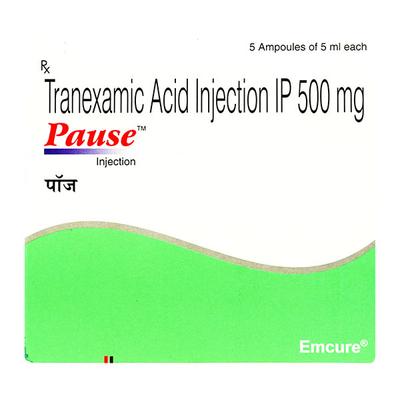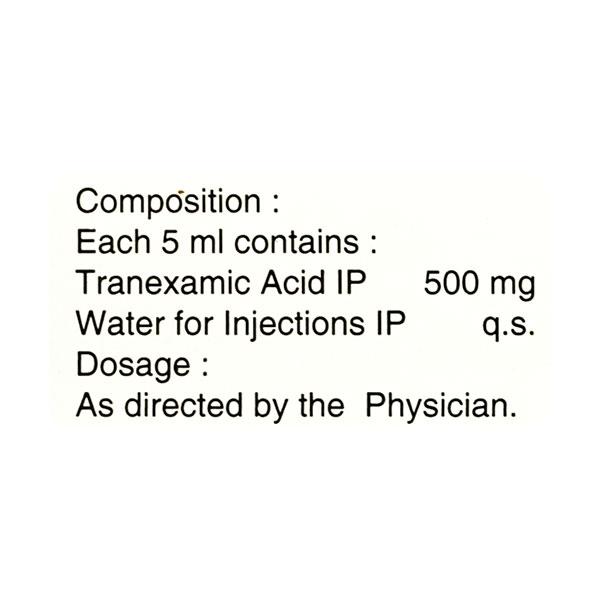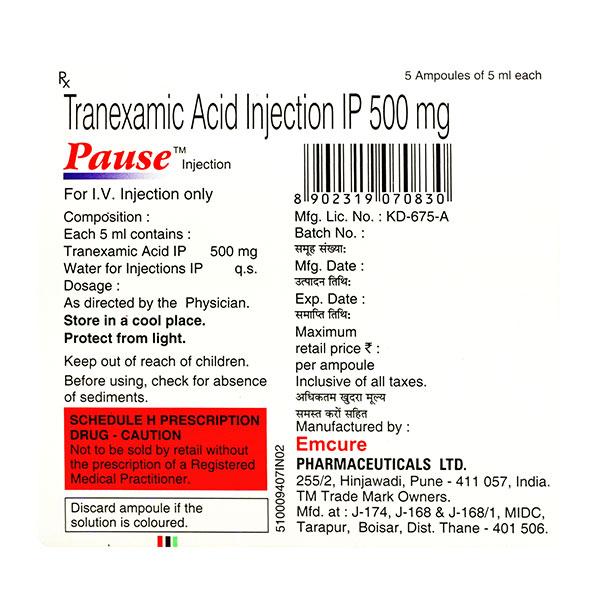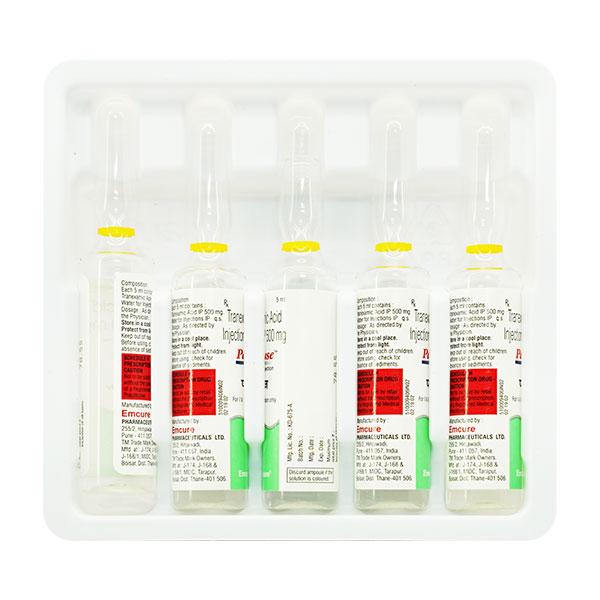

Netmeds First Membership
Quick Links
Introduction About PAUSE INJECTION
PAUSE INJECTION contains Tranexamic Acid which belongs to the group of medicines called Antifibrinolytics. It is used in the management of bleeding in conditions such as heavy menstrual bleeding in women, gastrointestinal bleeding (bleeding in digestive tract, anywhere from the throat to rectum), bleeding due to thrombolytic therapy (medicine that is used to breakdown blood clots) and after having surgeries (such as ear, nose, throat, prostate gland, urinary tract, gynecological, abdominal or heart surgery) in adults and children above one year of age.
PAUSE INJECTION is not recommended for use in patients with severe kidney impairment, blood clotting disorder or consumption coagulopathy (condition affecting the blood’s ability to clot and stop the bleeding) or history of seizures (fits). Your doctor may recommend you to take relevant tests to understand your existing condition.
Before receiving PAUSE INJECTION, inform your doctor if you had or have blood in the urine, are at risk of having a blood clot, excessive clotting or bleeding throughout the body (disseminated intravascular coagulation).
PAUSE INJECTION is not recommended for use in the first trimester of pregnancy and in breast-feeding women. It should be used with caution in pregnant women only if clearly advised by the doctor. PAUSE INJECTION should be used with caution in elderly patients, especially in patients with the evidence of renal failure.
The most common side effects of receiving PAUSE INJECTION are nausea or vomiting and diarrhea. Inform your doctor immediately if any of the side effect worsens.
Uses Of PAUSE INJECTION
Prevent and manages bleeding in children (aged above one) and adults in conditions such as:
- heavy menstrual bleeding in women
- gastrointestinal bleeding
- after having surgeries (such as ear, nose, throat, heart, abdominal, gynaecological and prostrate or urinary tract surgery)
- bleeding due to medicine that is used to breakdown blood clots (thrombolytic therapy)
How PAUSE INJECTION Works
PAUSE INJECTION manages bleeding by blocking the plasminogen from binding with fibrin which results in bleeding. As a result, it manages and controls bleeding associated with various factors.
How to use PAUSE INJECTION
PAUSE INJECTION will be given to you only by a doctor or a nurse into a vein as an intravenous injection. Your doctor will decide the correct dose, frequency and duration for you depending upon your age, body weight and disease condition.
Side Effects Of PAUSE INJECTION
Common
- diarrhea
- nausea, vomiting
Uncommon
- skin rashes
Rare
Inform your doctor immediately if you experience any of the following side effects while receiving PAUSE INJECTION:
- severe allergic reaction (signs include redness of the skin and lumpy skin rashes, difficulty in breathing, swelling of face, mouth, lips or eyelids, unexplained high temperature (fever) and fainting)
- swelling of the throat that causes breathing and swallowing difficulty
- symptoms of a blood clot (such as swelling or pain in the legs or chest, headache, weakness of the face and limbs on one side of the body)
How To Manage Side Effects
Diarrhea
Drink lot of fluids, such as water to keep yourself hydrated. Avoid eating high-fat or spicy foods. Inform your doctor if the symptom gets worse.
Nausea And Vomiting
Stick to simple meals while receiving this medicine. Avoid eating oily rich, fried or spicy foods. Do not lie down or sleep immediately after eating. Inform your doctor if the symptom does not improve.
Warning & Precautions
Pregnancy
ContraindicatedPAUSE INJECTION is not recommended for use in the first trimester of pregnancy. It should be used with caution in pregnant women only if considered clearly necessary. Women of childbearing potential should use effective contraception during management with this medicine. Consult your doctor before receiving PAUSE INJECTION.
Breastfeeding
ContraindicatedPAUSE INJECTION is not recommended for use in breastfeeding women as it passes through breast milk. Consult your doctor for advice.
Kidney
Consult your doctorPAUSE INJECTION is not recommended for use in patients with severe kidney impairment. It should be used with caution in patients with mild to moderate kidney impairment. Your doctor may adjust the dose depending upon the kidney function. Consult your doctor before receiving PAUSE INJECTION.
Liver
Use with CautionPAUSE INJECTION can be used with caution in patients with liver impairment. Consult your doctor before receiving PAUSE INJECTION.
Allergy
ContraindicatedDo not receive PAUSE INJECTION if you are allergic to Tranexamic acid or any other ingredients of this medicine.
Use In Pediatrics
Use with CautionPAUSE INJECTION should be used with caution in children above 1 year of age. Your child’s doctor will adjust the dose based on the bodyweight of the child. Consult child’s doctor for advice before administration of PAUSE INJECTION.
Use In Geriatrics
Use with CautionPAUSE INJECTION should be used with caution in elderly patients, especially in patients with the evidence of renal failure. Consult your doctor before receiving PAUSE INJECTION.
Others
PAUSE INJECTION is not recommended for use if you:
- have blood clotting disorder or consumption coagulopathy (condition affecting the blood’s ability to clot and stop the bleeding)
- have history of seizures (fits)
Before receiving PAUSE INJECTION, inform your physician if you:
- have blood in the urine (which may lead to urinary tract obstruction)
- are at risk of having a blood clot
- have excessive clotting or bleeding throughout the body (disseminated intravascular coagulation)
Interactions
A. Drug-Drug interactions:
Before receiving PAUSE INJECTION, inform your doctor if you have received or taking any of the following medicines:
- ethinyl estradiol, levonorgestrel (oral contraceptives used to manage pregnancy)
- thrombolytic agents such as streptokinase, reteplase, tenecteplase (medicines that manage blood clot)
- antifibrinolytics such as aminocaproic acid, aprotinin (medicines that help the blood to clot)
Overdosage:
PAUSE INJECTION will be given to you only by a doctor or nurse in a hospital, and so it is unlikely to receive an overdose. However, if you experience any unusual symptoms contact your doctor immediately. Symptoms include dizziness, headache, low blood pressure and convulsions (fits).
Synopsis
| Drug | : | Tranexamic Acid |
| Pharmacological Category | : | Antifibrinolytics |
| Therapeutic Indication | : | Prevent and manages bleeding in certain conditions |
| Dosage Forms | : | Injection, Gel, Tablet |
More Information
- Store at room temperature
FAQs About PAUSE INJECTION
Q: Can PAUSE INJECTION be used in elderly patients?
A: PAUSE INJECTION should be used with caution in elderly patients, especially in patients with the evidence of renal failure. Consult your doctor for advice before receiving PAUSE INJECTION.
Q: Is PAUSE INJECTION safe to use during pregnancy?
A: PAUSE INJECTION is not recommended for use in the first trimester of pregnancy. It should be used with caution in pregnant women only if clearly advised by the doctor. Women of childbearing potential should use effective contraception during management with this medicine. Consult your doctor before receiving PAUSE INJECTION.
Q: Can PAUSE INJECTION be used in patients with impaired kidney function?
A: PAUSE INJECTION is not recommended for use in patients with severe kidney impairment. It should be used with caution in patients with mild to moderate kidney impairment. Your doctor may adjust the dose depending upon the kidney function. Consult your doctor before receiving PAUSE INJECTION.
Q: Does PAUSE INJECTION cause nausea?
A: Yes, PAUSE INJECTION may cause nausea in some individuals. To manage this effect, stick to simple meals while receiving this medicine. Avoid eating oily rich, fried or spicy foods. Do not lie down or sleep immediately after eating. Inform your doctor if the symptom does not improve.
Q: How PAUSE INJECTION is administered?
A: PAUSE INJECTION will be given to you only by a doctor or a nurse into a vein as an intravenous injection. It should not be injected into a muscle (intramuscularly). Your doctor will decide the correct dose, frequency and duration for you depending upon your age, body weight and disease condition.
References
1. KD. Tripathi. Drugs affecting blood and blood formation. Essentials of medical pharmacology. Eighth Edition. 2019. Page – 676.
2. John M. Chauncey, Jerald S. Wieters. Tranexamic Acid. NIH. National Library of Medicine, National center for biotechnology information. [Revised in January 2022] [Accessed on 14th July 2022] https://www.ncbi.nlm.nih.gov/books/NBK532909/
3. Johnny Cai, Jessica Ribkoff, Sven Olson, Vikram Raghunathan, Hanny Al-Samkari, Thomas G. DeLoughery, and Joseph J. Shatzel. The many roles of tranexamic acid: An overview of the clinical indications for TXA in medical and surgical patients. NIH National Library of Medicine, National center for biotechnology information. Pubmed Central. December 2019 [Accessed on 14th July 2022] https://www.ncbi.nlm.nih.gov/pmc/articles/PMC7023891/
4. Accord Healthcare Limited. Electronic Medicines Compendium (EMC). [Revised in July 2022] [Accessed on 14th July 2022] https://www.medicines.org.uk/emc/files/pil.8953.pdf
5. Emcure Pharma UK Ltd. Electronic Medicines Compendium (EMC). [Revised in December 2021] [Accessed on 14th July 2022] https://www.medicines.org.uk/emc/product/11894/smpc
6. Medochemie Ltd. Electronic Medicines Compendium (EMC). [Revised in May 2018] [Accessed on 14th July 2022] https://www.medicines.org.uk/emc/files/pil.3374.pdf
Useful Diagnostic Tests
- Complete blood count
- Liver function test
- Kidney function test
- Bleeding Time/clotting time
- Eye test












